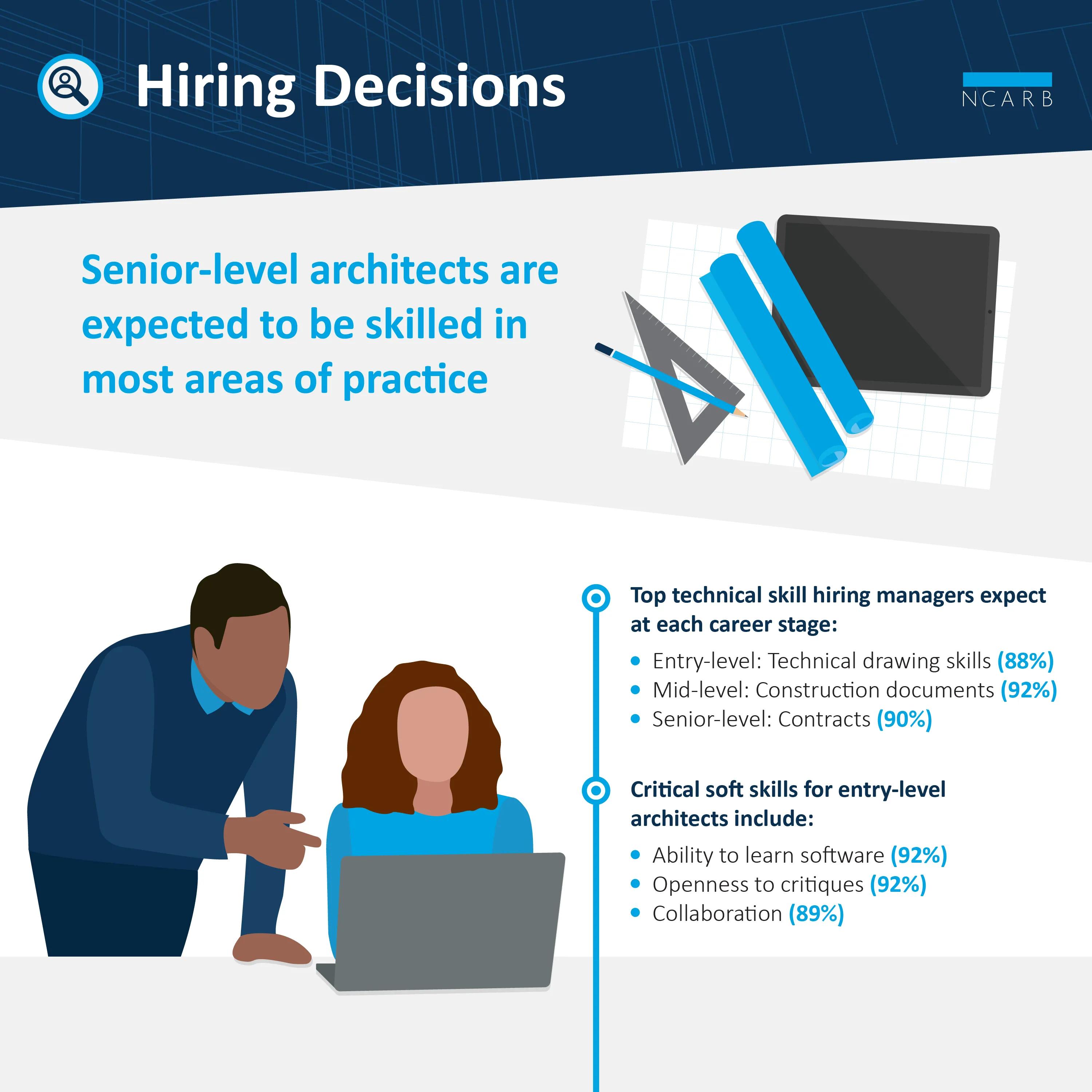While the core purpose of NCARB’s Analysis of Practice is to inform the evolution of the requirements for licensure and post-licensure professional development, NCARB also wanted to distinguish between the knowledge and skills necessary for licensure, versus what knowledge and skills firms look for when hiring. Thousands of individuals responsible for hiring decisions—including licensed architects and other collaborators—responded to questions about the qualities they look for when hiring entry-, mid-, and senior-level architects.

Knowledge, Skills, and Experience
When asked to identify the knowledge and skills they look for when hiring architects at various career levels, respondents selected the fewest skill areas for entry-level architects. Senior-level architects, by contrast, were expected to be skilled in almost every area. The top five skills per career level included:
| Entry | Mid | Senior |
| 1. Technical drawing skills (CAD/BIM) (88%) 2. Technology skills, including 3D modeling and rendering, virtual reality, and augmented reality (80%) 3. Design (69%) 4. Research skills (67%) 5. Sketching skills (65%) |
1. Construction documents (92%) 2.Documentation (90%) 3. Detailing (90%) 4.Codes (89%) 5. Life safety (88%) |
1. Contracts (90%) 2. Coordination (88%) 3. Life safety (88%) 4. Constructability (88%) 5. Legal implications of practice (88%) |
While this table shows the top five per career level, most skills were selected for senior-level architects at similar rates, making it difficult to distinguish a top five.
Interestingly, while technical drawing skills and technology skills were the top skill areas identified for entry-level architects, they were among the few skills that were less selected for senior-level architects.
When asked to identify the average years of experience needed to be considered at each level, respondents indicated that entry-level architects should have 0-3 years of experience, mid-level architects should have 3-7, and senior-level architects should have 10+.
Other Attributes
Respondents were also asked to identify soft skills that they consider most important when making hiring decisions.
| Entry | Mid | Senior |
| - Ability to Learn Software - Openness to Critiques - Collaboration/Teamwork - Professionalism |
- Collaboration/Teamwork - Professionalism - Problem Solving - Verbal Communication |
- Decision Making - Leadership - Problem Solving - Project Management
|
Background and Education
Respondents indicate that firms typically seek diversity when hiring architects. They do not place a high value on having a degree from a National Architectural Accrediting Board (NAAB) accredited program, and they make even less of a distinction between Master and Bachelor of Architecture degrees.
Demographic Differences
There were very few differences across demographic groups when reviewing hiring decisions. The majority of differences revolved around the size of the workplace, years of experience, and the number of architects, including:
- More experienced respondents expected more years of experience and skills for individuals at all career levels
- While hiring managers did not require any specific certification, LEED certification was the most commonly preferred
- Specifically, LEED certification was most beneficial when making hiring decisions for firms with a high number of architects
What’s Next?
Over the coming years, NCARB will continue exploring the relationship between hiring qualifications and requirements for licensure. Findings from the Analysis of Practice will inform what the licensure process will look like in the future.
About the Analysis of Practice
In 2022, over 19,000 individuals across the architecture, engineering, and construction (AEC) industry participated in NCARB’s once-in-a-decade Analysis of Practice study. Through a series of short questionnaires, focus groups, a final extensive survey, and more, NCARB gathered key insights about the field of architecture that will help shape the licensing model of the future. Results from the study will help us better understand the ecosystem of architectural practice and may lead to changes to NCARB’s national licensing programs and standards of the future.